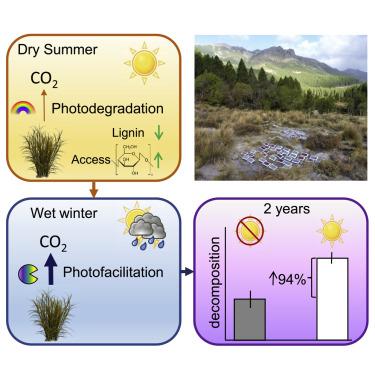Current Biology ( IF 8.1 ) Pub Date : 2020-07-02 , DOI: 10.1016/j.cub.2020.06.005 Paula Berenstecher 1 , Lucía Vivanco 1 , Luis I Pérez 1 , Carlos L Ballaré 2 , Amy T Austin 1

|
Photodegradation of aboveground senescent plant material (plant litter) due to exposure to solar radiation has been identified as a dominant control on carbon (C) loss in semi-arid ecosystems [1], upturning traditional models of C cycling based only on available moisture and litter quality. In addition to the photochemical mineralization of organic matter [1, 2], sunlight alters the chemistry of cell walls in plant litter [3, 4], making them more susceptible to subsequent biotic degradation [5, 6, 7]. Nevertheless, the interactive effects of sunlight exposure, climate seasonality, and biotic decomposition on C turnover remain unresolved in terrestrial ecosystems. We show here that exposure to sunlight accelerated litter decomposition in a Patagonian woodland with a marked dry summer season. Controls on initial decomposition varied seasonally from direct photochemical mineralization in the dry summer to biotic degradation in the wet winter. By manipulating sunlight received by plant litter using spectral filters that attenuated ultraviolet and short-wave visible light, we demonstrate that direct photodegradation and its legacy, associated with increased microbial access to labile carbohydrates, are responsible for the acceleration of aboveground C turnover in this Mediterranean-type climate. Across plant species and over a 2-year period, litter exposed to the full solar spectrum decomposed twice as fast as litter that received attenuated sunlight. Changes in vegetation cover or biodiversity due to projected increased drought and dry season length [8] will likely exacerbate C losses from aboveground litter due to sunlight exposure, negatively impacting the C balance in ecosystems that are particularly vulnerable to global change [9].
中文翻译:

巴塔哥尼亚季节性干燥林地的阳光使地上碳损失加倍。
由于暴露在太阳辐射下,地上衰老植物材料(植物凋落物)的光降解已被确定为半干旱生态系统中碳 (C) 损失的主要控制因素 [1],颠覆了仅基于可用水分和垃圾质量。除了有机物的光化学矿化 [1, 2],阳光还会改变植物凋落物中细胞壁的化学性质 [3, 4],使它们更容易受到随后的生物降解 [5, 6, 7]。然而,在陆地生态系统中,阳光照射、气候季节性和生物分解对 C 周转的交互影响仍未得到解决。我们在这里表明,在夏季明显干燥的巴塔哥尼亚林地中,暴露在阳光下会加速凋落物分解。对初始分解的控制随季节变化,从干燥夏季的直接光化学矿化到潮湿冬季的生物降解。通过使用衰减紫外线和短波可见光的光谱滤光片来操纵植物凋落物接收到的阳光,我们证明直接光降解及其遗留物与微生物对不稳定碳水化合物的获取增加有关,是该地中海地区地上 C 周转加速的原因-型气候。在整个植物物种中,在 2 年的时间内,暴露在全太阳光谱下的凋落物的分解速度是接受衰减阳光的凋落物的两倍。由于预计干旱和旱季长度增加而导致植被覆盖或生物多样性的变化 [8] 可能会加剧由于阳光照射导致的地上凋落物的碳损失,










































 京公网安备 11010802027423号
京公网安备 11010802027423号